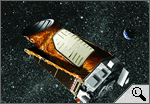|
|
|
 |
 |
 > More than 300 Planets Identified... > ...But None Like Earth > Why the Name 'Kepler'? dimarts, 3 de març de 2009
The countdown to the Kepler Mission has started. On Friday 6 March, the National Aeronautics and Space Administration (NASA) is set to launch an extremely powerful telescope into space from the Cape Canaveral space station in Florida (USA). The objective, which is certainly ambitious, is to identify habitable planets like ours.
The Kepler Mission will explore a vast region of space in the Cygnus and Lyra constellations looking for terrestrial planets (i.e., planets one half to twice the size of the Earth), in particular those that orbit in habitable zones (we'll see later what is meant by 'habitable zones'). The mission will last three-and-a-half years (although it may run for as long as six years) and will observe more than 100,000 stars. The method to find out whether these stars are orbited by Earth-like planets is, apparently simple. It is based on the phenomenon known as 'transit', which refers to the path of a planet viewed from in front of the star it orbits. During the transit, the star emits less light. The telescope on the Kepler Mission will be capable of measuring any changes to the light emitted and, according to these changes, will be able to determine whether the planet that passes in front of the star is bigger or smaller, and whether it is comparable in size to the Earth or not.
More than 300 Planets Identified...Ultimately, the Kepler Mission returns to the question of whether Earth is unique or whether, on the contrary, there are other worlds similar to ours. Interest in this question, which Man has been asking since the dawn of mankind, has increased since the discovery of extrasolar planets, i.e. planets that are outside our Solar System. The first discovery of these planets was made in 1995. Since then, nearly 340 more have been discovered, all with Earth-based telescopes. The majority of extrasolar planets are massive, similar in size to Jupiter. They have short orbits and stay close to their stars, meaning they are extremely hot (too hot for life to be possible).
...But None Like EarthUntil now, however, no small, rocky planets like Earth have been discovered. The task of the Kepler Mission is, therefore, to find planets like Earth, located in so-called habitable zones. A habitable zone describes the area in space where conditions are right for life, as we know it on Earth. In other words, planets (if there are any) that have liquid water on the surface (something none of the gigantic, gassy planets discovered to date have had).
Why the Name 'Kepler'?The mission is called the Kepler Mission in honour of the German astronomer Johannes Kepler (1571-1630), one of the first supporters of the heliocentric model put forward by Nicolaus Copernicus (1473-1543) who argued that the centre of the cosmos was the Sun, not the Earth. This year marks the 400th anniversary of the publication of Kepler's 'Astronomia nova' (New Astronomy), a key work in astronomy, in which he set out the first two principles (also known as 'Kepler's Laws') of planetary motion: that the planets orbited the Sun in ellipses and that they moved more quickly as they approached the Sun.
|
Investiga

> Vídeo de la missió Kepler.

> El mètode per a cercar planetes habitables: animació.
I també...
- Missió Kepler: preguntes i respostes.
- Breu biografia de Johannes Kepler.
- Sobre la Via Làctia, la galàxia a què pertany el Sistema Solar.
- 'Contes d'estrelles'.
Portada |
Europa Press |
El Punt |
La premsa |
Especials |
Diari de l'escola |
LesFinances.info |
Editorials |
Mail obert |
Els blocs |
Lletres
Tecnologia i ciència | Solidaritat | Cap de 7mana | Campus | El 9 | Presència | Fòrums | Enquestes | Xat | Correu
Traductor | Edicions en Pdf | Wap-pda | Biblioteca | Lletra més grossa
Tecnologia i ciència | Solidaritat | Cap de 7mana | Campus | El 9 | Presència | Fòrums | Enquestes | Xat | Correu
Traductor | Edicions en Pdf | Wap-pda | Biblioteca | Lletra més grossa
| Què és VilaWeb? Publicitat Mapa web Contacte | Una web de Partal, Maresma i Associats, S.L. |






